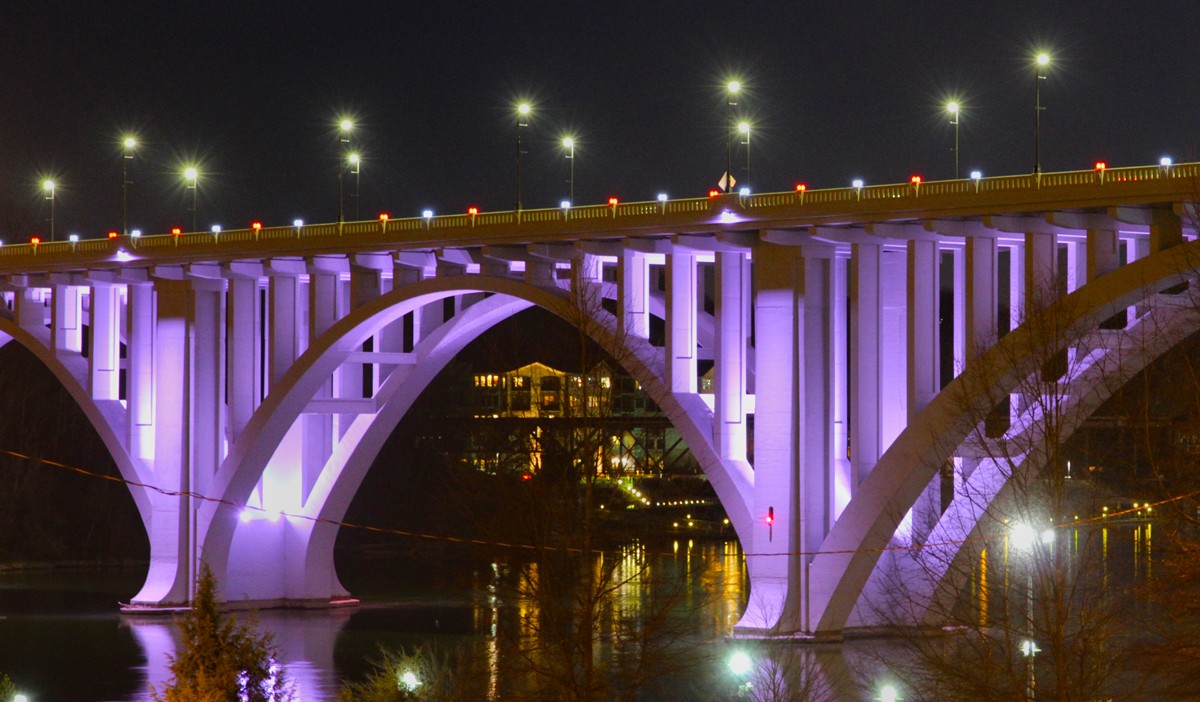Long ago – mostly likely before your time – South Knoxville was derogatorily dubbed “South America” by residents of other parts of town. It was a journey to get there, and although some pockets were highly regarded destinations, others were rural and/or rough and tumble.
The Tennessee River, formed by the juncture of the French Broad and Holston rivers to the east, separates Knoxville proper from South Knoxville. A succession of bridges at the eastern edge of downtown allowed for traffic in the 19th century, with the completion of the Gay Street Bridge in 1898 creating a sturdy, more permanent crossover.
The iconic Henley Bridge became a prospect in the 1920s when civic leaders envisioned a highway that would link Knoxville with the future Great Smoky Mountains National Park to the south.
A bond issue in 1928 provided funding, but it took until Sept. 30, 1930, for construction to begin. J.E. Griner Co. of Baltimore, Maryland, was hired to design the bridge but fired when the company wanted to settle for a two-lane bridge with a width of 36 feet. Henley Street was being widened, and proponents of the “Gateway to the Smokies” were calling for a four-lane bridge that was 54 feet wide from curb to curb.
Marsh Engineering Co. of Des Moines, Iowa, submitted a design including those specifications, and after much debate that plan was selected.
It wasn’t all smooth sailing for veteran bridge engineer James B. Marsh during construction, however. The city insisted on installing locals L.M. Dow and S.B. Goodsey as supervising engineer and resident engineer, respectively, instead of letting Marsh choose his own construction supervisor, and many modifications were made to Marsh’s design.
The bridge was completed by Pittsburgh, Pennsylvania, contractor Booth and Flinn in late 1931 and dedicated on Jan. 2, 1932. The city and Knox County split the final price tag of $1.15 million.
Now, about the name. It’s the Henley Bridge, not the Henley Street Bridge. Both the bridge and the street are named for Col. David Henley, who rose to prominence during the Revolutionary War.
Henley was born Feb. 5, 1749, in Charlestown, Massachusetts. He served under Generals William Heath and Joseph Spencer before Gen. George Washington chose him to be his spymaster in November 1778. He reported to Washington on the British army’s capabilities.
In 1793, President Washington appointed Henley to be the agent of the Department of War for the Southwest Territory, based in Knoxville. His duties included serving as Superintendent of Indian Affairs as well as quartermaster and paymaster for troops and militia stationed in the area. He held those roles until 1801.
His office at the corner of what is now Gay Street and Church Avenue was the site of Tennessee’s first Constitutional Convention in 1796. Henley died Jan. 1, 1823, in Washington, D.C., where he was serving as a clerk in the War Department.
On Nov. 2, 1932, the Bonny Kate and James White chapters of the Daughters of the American Revolution installed a dedicatory plaque on the bridge in honor of Henley. The main speaker at the event was Dean James D. Hoskins of the University of Tennessee.
In 1964, the Knoxville City Council voted to rename the bridge to honor recently deceased Mayor George R. Dempster, but the public never accepted the name.
The Henley Bridge underwent extensive renovations from 2011 to 2014, with delays running the cost up to $31,100,000. Two workers died during the construction, and South Knoxville businesses were crippled both during and after the work.
With I-40 connecting tourists to a newer route to the Smokies, the Henley Bridge is no longer the gateway it was in its early years. But South Knoxville businesses have rebounded, and Chapman Highway, which starts at the south end of the bridge, is South Knoxville’s Main Street once again.
Betsy Pickle is a freelance writer and editor who particularly enjoys spotlighting South Knoxville.


